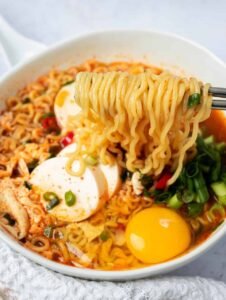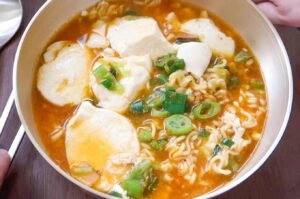In what manner do you prefer to enhance the flavor of instant ramyun, also known as ramen or 일면? In spite of the fact that I am not a huge lover of quick noodles, I do occasionally find myself yearning them. This is especially true after I have witnessed someone in a Korean drama devouring them. In most cases, I enhance it by including some vegetables in addition to an egg. On the contrary, I had never considered including sundubu (also known as extra soft tofu, 순두부) until I witnessed it gaining widespread popularity on Korean social media platforms.

What a fantastic concept! Sundubu, which can also be spelled soondubu, is essentially added to a spicy ramyun, which can also be spelled ramyeon, noodle soup within the dish. It is really similar to having ramyun and sundubu jjigae (stew) in the same plate. Additionally, there is a substitution of high-protein soft tofu for half of the ramyun noodles, which results in a dish that is healthier. Instant noodles are a significant component of the contemporary Korean culinary culture. In the 1960s, Samyang Ramyun Company, the sole brand of ramyun that we had grown up on, was the one who initiated everything. With an increasing popularity all over the world, instant noodles are now available in a wide variety of tastes and variations, and there are many rivals. As a comfort food, it is both convenient and inexpensive.
The news media reported that South Korean instant noodles reached a record high of $606 million in exports in the year 2020, representing a nearly 30 percent increase from the previous year. The lockdown has reportedly resulted in an increase in the use of instant noodles by individuals. There was also a big contribution made by the worldwide popularity of “Jjapaguri” from the film Parasite, which was a major factor in the increase. Additionally, it is beneficial to have ramyun noodles on hand because they are an excellent complement to a variety of other recipes, including budae jjigae (also known as army stew), tteokbokki (also known as spicy stir-fried rice cakes), and many others.
Sundubu Ramyun
The Yeol Ramyun ingredient is used in the recipe that became viral in Korea. Yeol (Heat) is a word. You are free to use any spicy instant noodles, such as Shin Ramyun or Jin Ramyun Spicy, or you can use the version of your choice that does not contain any spices.
It is recommended that you use half of the ramyum package and half of the soondubu tube for each serving in the recipe. For the purpose of giving it a flavor that is somewhat similar to that of sundubu jjigae, I included a stage in which I made garlic-infused chili oil using the ramyun spice mix and some gochugaru, which was optional.

Scallions that have been diced and an egg are two ingredients that are typically included in Korean ramyun. It is possible to leave out the egg. In addition, if you would like, you are free to include a small quantity of additional veggies, such as mushrooms, bean sprouts, or onion at your discretion. As a side note, the sort of pot that I utilized in this instance is known as yangeun naembi (양은냄비), which is a pot made of aluminum that is plated with nickel silver. In the past, pots made of aluminum were frequently used until they were supplanted by cookware made of more superior materials. Due to their thinness, they are prone to denting. At this point in time, people use them for a more nostalgic feeling, particularly when it comes to instant noodles. Due to the fact that it heats up so quickly, instant ramyun is an excellent choice for cooking.
Ingredients
- 1/2 package sundubu, 순두부
- 1/2 package spicy ramyun, 라면 or your favorite
- 1 tablespoon chopped scallion
- 1/2 teaspoon minced garlic
- 1/2 tablespoon sesame oil
- 1/4 teaspoon gochugaru, 고추가루 – optional
- 1 egg
- pinch pepper
Instructions
-
Add the sesame oil, garlic and 1/2 of the ramyun seasoning mix and optional gochugaru to a small pot and mix well over medium heat for a few seconds.
-
Add 1 cup of water. Turn the heat up to medium high. When water boils, add the sundubu in big chunks, and bring it to a boil.
-
Drop the noodles in, and then add 1/2 packet of the vegetable flakes. Continue to boil until the noodles are almost cooked, about 3 minutes. The noodles should be al dente at this point.
-
Crack an egg straight over the noodles. You can break the egg yolk and stir into the soup if you want. Turn the heat off, and drop the scallion in, and sprinkle with pepper to taste.
FAQ:
What is Sundubu Ramyun?
Sundubu Ramyun is a Korean spicy soft tofu stew (sundubu jjigae) combined with instant ramen noodles (ramyun). It’s a popular and flavorful dish known for its spicy, savory broth and soft tofu, often enjoyed as a comforting meal.
What are the key ingredients in Sundubu Ramyun?
The main ingredients include soft tofu (sundubu), instant ramen noodles, broth (usually made with ingredients like dashi, anchovy stock, or beef or pork broth), spicy seasoning paste (gochujang or gochugaru), aromatics (garlic, ginger, green onions), and various optional additions like seafood, vegetables, or meat.
Is Sundubu Ramyun spicy?
Yes, Sundubu Ramyun is typically spicy due to the use of gochujang (Korean chili paste) or gochugaru (Korean chili flakes) in the broth. However, the level of spiciness can be adjusted according to personal preference by varying the amount of chili paste or flakes used.
Can Sundubu Ramyun be customized?
Yes, Sundubu Ramyun can be customized based on personal taste preferences and dietary restrictions. Additional ingredients such as mushrooms, clams, shrimp, or pork can be added to enhance the flavor and texture. Vegetables like zucchini, onions, or spinach can also be included for added nutrition.
Is Sundubu Ramyun vegetarian/vegan-friendly?
Sundubu Ramyun can be made vegetarian or vegan by using vegetable broth instead of meat-based broth and omitting any animal-based ingredients like seafood or meat. Additionally, vegan-friendly instant ramen noodles and seasoning can be used.
How do you make Sundubu Ramyun?
Sundubu Ramyun is typically made by first preparing the spicy broth base with aromatics, seasoning paste, and broth. Soft tofu is then added to the simmering broth along with any additional ingredients like vegetables or protein. Instant ramen noodles are cooked separately and added to the stew just before serving.
What are some common side dishes served with Sundubu Ramyun?
Common side dishes that pair well with Sundubu Ramyun include kimchi, pickled radishes (danmuji), and a variety of banchan (Korean side dishes) such as seasoned vegetables, marinated tofu, or fish cakes.
Can Sundubu Ramyun leftovers be stored?
Yes, leftovers of Sundubu Ramyun can be stored in an airtight container in the refrigerator for up to 2-3 days. However, the noodles may become soggy over time, so it’s best to consume them within a day or two for optimal texture.
ALSO READ: Korean Potato Salad
